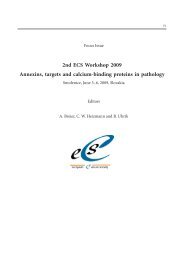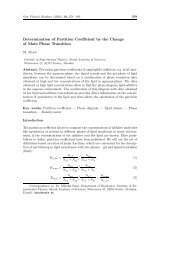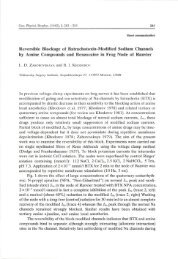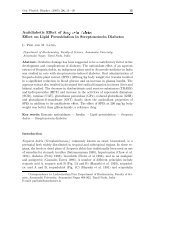Inhibition of Restriction Endonuclease Cleavage due to ... - Gpb.sav.sk
Inhibition of Restriction Endonuclease Cleavage due to ... - Gpb.sav.sk
Inhibition of Restriction Endonuclease Cleavage due to ... - Gpb.sav.sk
Create successful ePaper yourself
Turn your PDF publications into a flip-book with our unique Google optimized e-Paper software.
328 Paleček et al.<strong>to</strong> superhelicity some structural forms <strong>of</strong> DNA are stabilized (e. g. cruciformsand left-handed Z-helices), which do not occur in non-superhelical DNA underphysiological conditions (Rich et al. 1984). These local perturbations <strong>of</strong> doublehelicalDNA which occur in regions with specific nucleotide sequences probablyplay an important role in the regulation <strong>of</strong> gene expression, and have thereforebeen studied intensively in recent years. Until recently the research on localconformational changes in superhelical DNA was mainly undertaken usingsingle-strand selective nucleases (especially nuclease SI). Their use is based onthe fact that these conformational changes usually include a portion <strong>of</strong> basesmore accessible <strong>to</strong> interaction with the environment than those contained in Bform. The interpretation <strong>of</strong> results obtained using these nucleases is made moredifficult by the fact that the mechanism <strong>of</strong> their action on DNA is not knownin detail and that the interaction <strong>of</strong> protein with DNA can induce DNAstructural changes.In studying the polymorphism <strong>of</strong> double helical DNA in the past, themethods <strong>of</strong> electrochemical analysis (Paleček 1976; Paleček 1983) have beenfound <strong>to</strong> be advantageous, though they do not allow the location <strong>of</strong> the structuralchange in the DNA molecule <strong>to</strong> be determined. Several years ago we turnedour attention <strong>to</strong> the development <strong>of</strong> chemical probes <strong>of</strong> DNA structure whichwould form electroactive markers in the polynucleotide chain detectable bymodern electrochemical analysis and which would extend significantly the methodicalreper<strong>to</strong>ire <strong>of</strong> DNA structure research. We found Os0 4with pyridine(Paleček et al. 1981; Lukášova et al. 1982; Paleček and Hung 1983) <strong>to</strong> be anelectroactive marker and a probe <strong>of</strong> DNA structure. Using it we detectedstructural changes in linear (Lukášova et al. 1982; Paleček and Hung 1983;Lukášova et al. 1984; McClellan et al. 1986) and superhelical (Lukášova et al.1984; Glikin et al. 1984; Lilley and Paleček 1984; Nejedlý et al. 1985) DNAmolecules. We have recently shown that this structural probe is capable <strong>of</strong>recognizing structural dis<strong>to</strong>rtions at the junction between B and Z segments insupercoiled plasmid DNA. To map the osmium binding site we used subsequentcleavage with restriction and single-strand selective nucleases and gel electrophoresis<strong>of</strong> the DNA fragments (Nejedlý et al. 1985). The precision <strong>of</strong> thismapping is limited by the fact that it is not known how exactly nuclease SI (usedas a single-strand selective nuclease) recognizes and cleaves the chemicallymodified region. Moreover, it is rather doubtful whether this enzyme is able <strong>to</strong>recognize a single solitary osmium modified nucleotide. We therefore tried <strong>to</strong>apply other methods <strong>to</strong> ensure higher precision and/or sensitivity <strong>of</strong> mapping(Paleček 1986; Galazka et al. 1986; McClellan et al. 1986). One <strong>of</strong> theseapproaches is based on the inhibition <strong>of</strong> restriction cleavage <strong>due</strong> <strong>to</strong> chemicalmodification <strong>of</strong> the recognition site (Nejedlý et al. 1985). In this work we haveapplied this method <strong>to</strong> study the B-Z junctions in the superhelical plasmid









